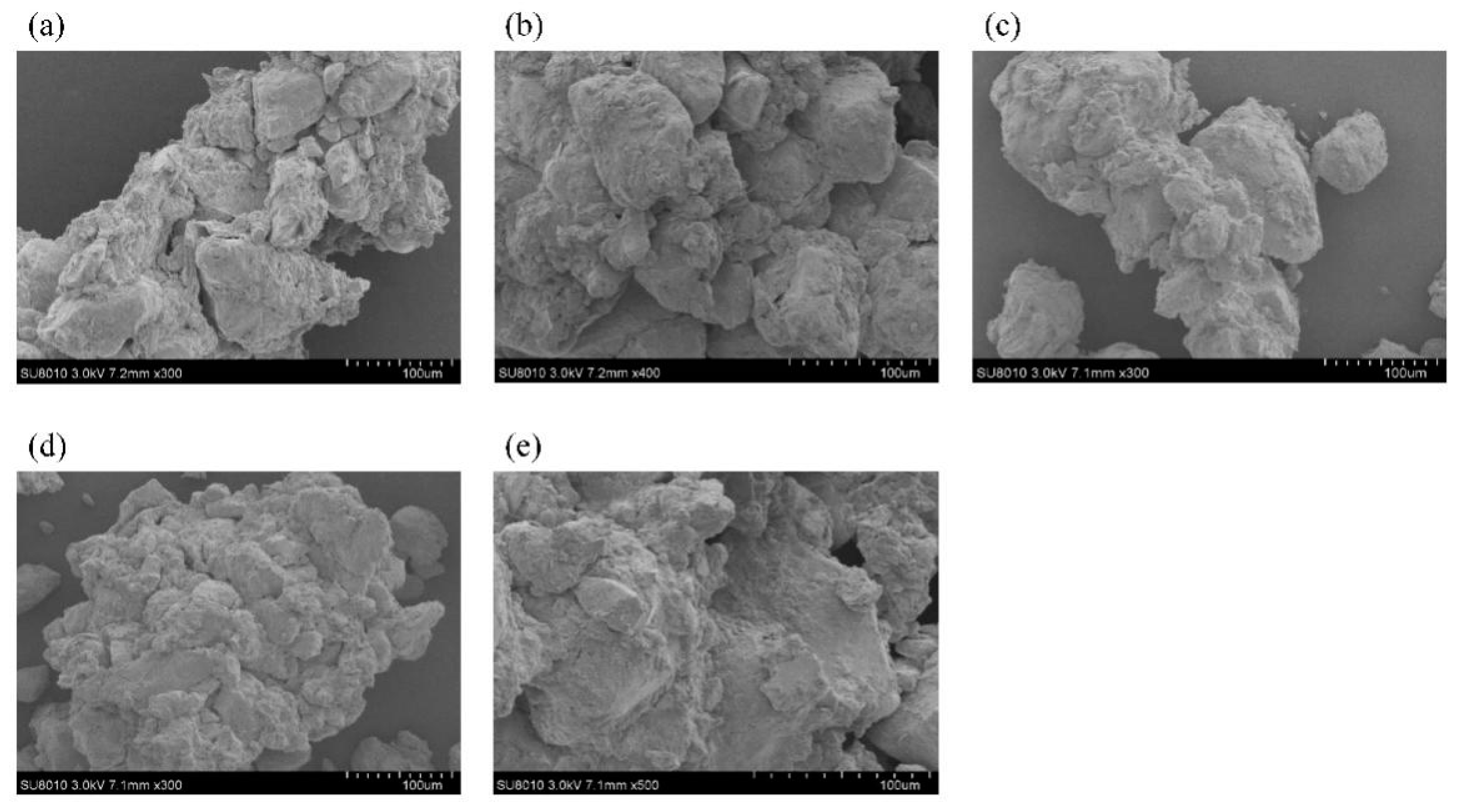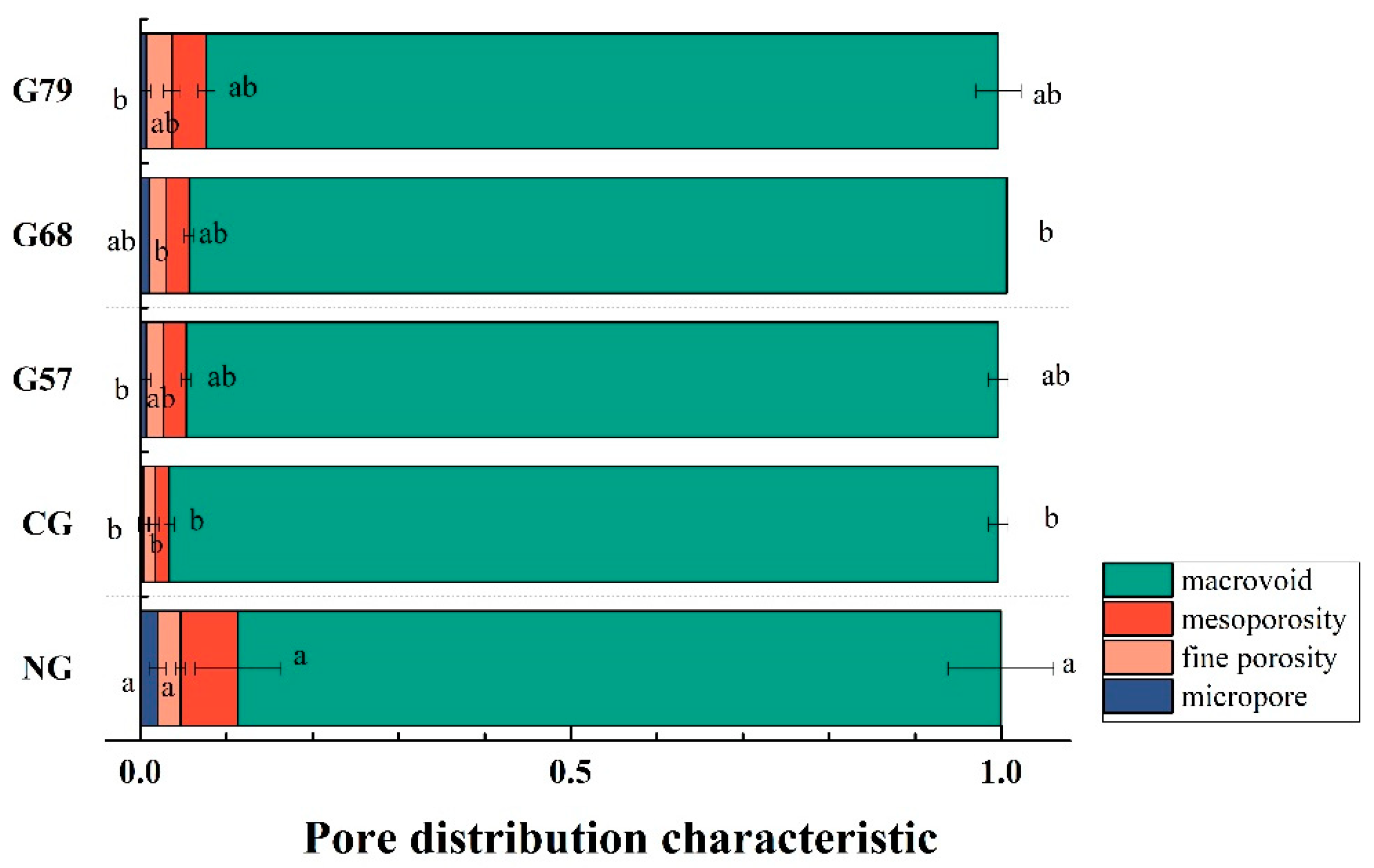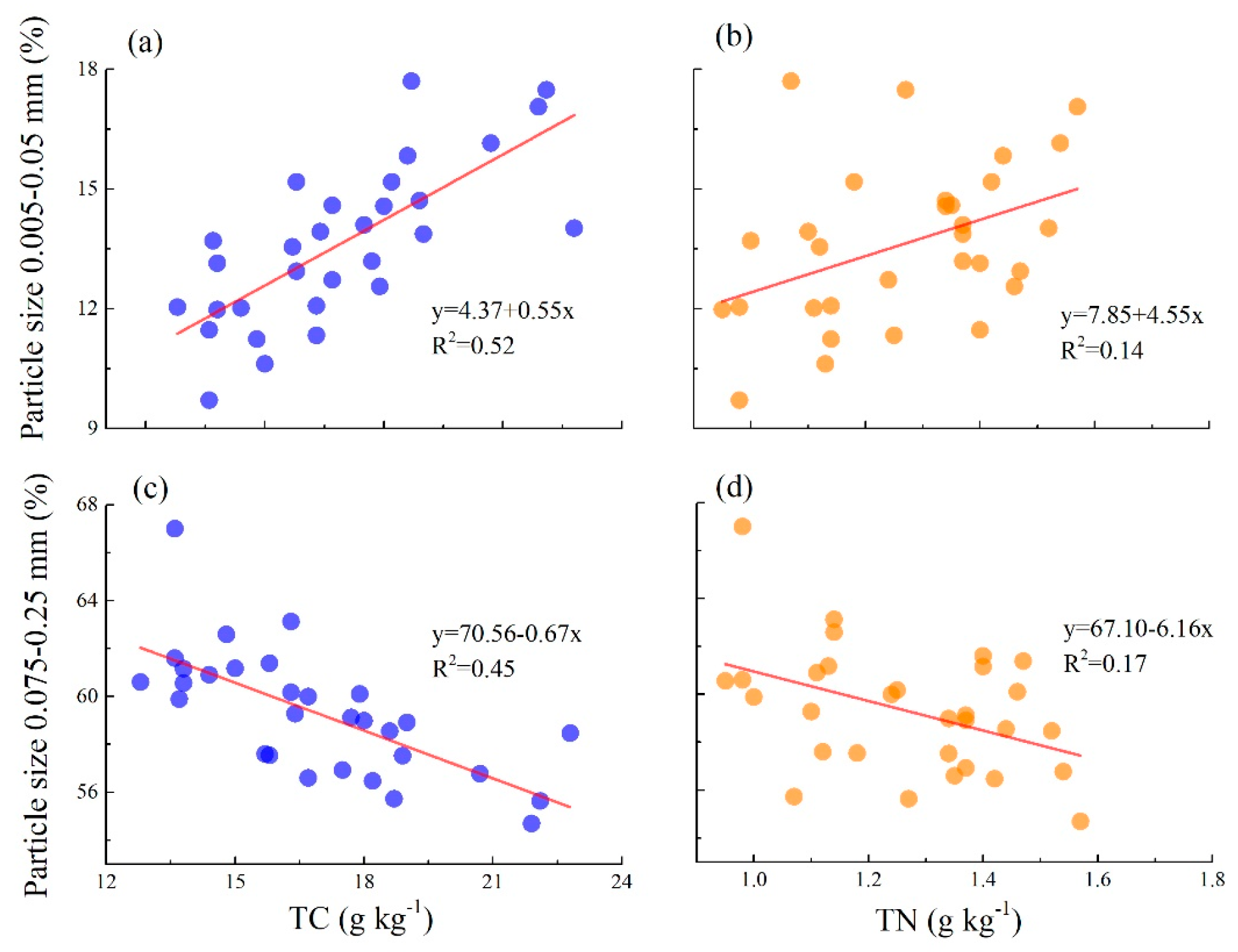Seasonal Grazing Does Not Significantly Alter the Particle Structure and Pore Characteristics of Grassland Soil
Abstract
1. Introduction
2. Methods
2.1. Study Area
2.2. Grazing Experiment Design
2.3. Soil Sampling and Physicochemical Analysis
2.4. Data Analysis
3. Results
3.1. Soil Properties
3.2. Soil Particle and Pore Distribution Characteristic
3.3. Relationships between Soil Physicochemical Properties and Soil Particle and Pore Structure
4. Discussion
4.1. Changes in Soil Physics Caused by Livestock Trampling
4.2. The Impact of Seasonal Grazing on Soil Structure
4.3. Relationships between Soil Structure and Soil Ecological Functions
5. Conclusions
Author Contributions
Funding
Data Availability Statement
Acknowledgments
Conflicts of Interest
References
- Chen, L.L.; Wang, K.X.; Baoyin, T. Effects of grazing and mowing on vertical distribution of soil nutrients and their stoichiometry (C: N: P) in a semi-arid grassland of North China. Catena 2021, 206, 8. [Google Scholar] [CrossRef]
- Ma, C.H.; Hao, X.H.; He, F.C.; Baoyin, T.G.; Yang, J.J.; Dong, S.K. Effects of seasonal grazing on plant and soil microbial diversity of typical temperate grassland. Front. Plant Sci. 2022, 13, 12. [Google Scholar] [CrossRef]
- Deepagoda, T.; Clough, T.J.; Jayarathne, J.; Thomas, S.; Elberling, B. Soil-gas diffusivity and soil-moisture effects on N2O emissions from repacked pasture soils. Soil Sci. Soc. Am. J. 2020, 84, 371–386. [Google Scholar] [CrossRef]
- Wei, Y.N.; Fan, W.; Yu, B.; Deng, L.S.; Wei, T.T. Characterization and evolution of three-dimensional microstructure of Malan loess. Catena 2020, 192, 14. [Google Scholar] [CrossRef]
- Adrover, M.; Farrús, E.; Moyà, G.; Vadell, J. Chemical properties and biological activity in soils of Mallorca following twenty years of treated wastewater irrigation. J. Environ. Manag. 2012, 95, S188–S192. [Google Scholar] [CrossRef]
- Bachmann, J.; Ellies, A.; Hartge, K.H. Development and application of a new sessile drop contact angle method to assess soil water repellency. J. Hydrol. 2000, 231, 66–75. [Google Scholar] [CrossRef]
- Leuther, F.; Schlüter, S.; Wallach, R.; Vogel, H.J. Structure and hydraulic properties in soils under long-term irrigation with treated wastewater. Geoderma 2019, 333, 90–98. [Google Scholar] [CrossRef]
- Arriaga, F.J.; Lowery, B.; Mays, M.D. A fast method for determining soil particle size distribution using a laser instrument. Soil Sci. 2006, 171, 663–674. [Google Scholar] [CrossRef]
- Arthur, E.; Moldrup, P.; Schjonning, P.; de Jonge, L.W. Linking Particle and Pore Size Distribution Parameters to Soil Gas Transport Properties. Soil Sci. Soc. Am. J. 2012, 76, 18–27. [Google Scholar] [CrossRef]
- Wei, Y.N.; Fan, W.; Wang, W.; Deng, L.S. Identification of nitrate pollution sources of groundwater and analysis of potential pollution paths in loess regions: A case study in Tongchuan region, China. Environ. Earth Sci. 2017, 76, 13. [Google Scholar] [CrossRef]
- Wen, B.P.; Yan, Y.J. Influence of structure on shear characteristics of the unsaturated loess in Lanzhou, China. Eng. Geol. 2014, 168, 46–58. [Google Scholar] [CrossRef]
- Xu, L.; Coop, M.R. Influence of structure on the behavior of a saturated clayey loess. Can. Geotech. J. 2016, 53, 1026–1037. [Google Scholar] [CrossRef]
- Kang, Z.; Tao-Getao, B. Effects of seasonal grazing and utilization on productivity of typical grassland communities. J. Grassl. Sci. 2014, 36, 109–115. [Google Scholar]
- Soares, M.D.R.; de Souza, Z.M.; Campos, M.C.C.; da Silva, R.B.; Esteban, D.A.A.; Noronha, R.L.; Gomes, M.G.D.; da Cunha, J.M. Land-use change and its impact on physical and mechanical properties of Archaeological Black Earth in the Amazon rainforest. Catena 2021, 202, 11. [Google Scholar] [CrossRef]
- McDonald, S.E.; Badgery, W.; Clarendon, S.; Orgill, S.; Sinclair, K.; Meyer, R.; Butchart, D.B.; Eckard, R.; Rowlings, D.; Grace, P. Grazing management for soil carbon in Australia: A review. J. Environ. Manag. 2023, 347, 16. [Google Scholar] [CrossRef]
- Ying, L.; Shixiong, L.; Yanlong, W.; al, e. Research progress on ecological restoration of degraded grassland affected by grazing. J. Shanxi Agric. Univ. (Nat. Sci. 362 Ed.) 2020, 40, 2–7. [Google Scholar]
- Brito, W.B.M.; Campos, M.C.C.; Mantovanelli, B.C.; da Cunha, J.M.; Franciscon, U.; Soares, M.D.R. Spatial variability of soil physical properties in Archeological Dark Earths under different uses in southern Amazon. Soil Tillage Res. 2018, 182, 103–111. [Google Scholar] [CrossRef]
- Frozzi, J.C.; da Cunha, J.M.; Campos, M.C.C.; Bergamin, A.C.; Brito, W.B.M.; Fraciscon, U.; da Silva, D.M.P.; de Lima, A.F.L.; de Brito Filho, E.G. Physical attributes and organic carbon in soils under natural and anthropogenic environments in the South Amazon region. Environ. Earth Sci. 2020, 79, 251. [Google Scholar] [CrossRef]
- Conte, O.; Flores, J.P.; Cassol, L.C.; Anghinoni, I.; Carvalho, P.C.; Levien, R.; Wesp, C.D. Evolução de atributos físicos de solo em sistema de integração lavoura-pecuária. Pesquisa agropecuária brasileira. Pesqui. Agropecu. Bras. 2011, 46, 1301–1309. [Google Scholar] [CrossRef]
- Drewry, J.J.; Cameron, K.C.; Buchan, G.D. Pasture yield and soil physical propertyresponses to soil compaction from treading and grazing—A review. Austr. J. Soil Res. 2008, 46, 237–256. [Google Scholar] [CrossRef]
- Nie, Z.N.; Ward, G.N.; Michael, A.T. Impact of pugging by dairy cows on pastures and indicators of pugging damage to pasture soil in south-western Victoria. Aust. J. Agric. Res. 2001, 52, 37–43. [Google Scholar] [CrossRef]
- Horn, R.; Domzal, H.; Slowinskajurkiewicz, A.; Vanouwerkerk, C. Soil compaction processes and their effects on the structure of arable soils and the environment. Soil Tillage Res. 1995, 35, 23–36. [Google Scholar] [CrossRef]
- de Aquino, R.E.; Campos, M.C.C.; Marques, J.; de Oliveira, I.A.; Teixeira, D.D.; da Cunha, J.M. Use of scaled semivariograms in the planning sample of soil physical properties in southern Amazonas, Brazil. Rev. Bras. Cienc. Solo 2015, 39, 21–30. [Google Scholar] [CrossRef]
- Kawa, N.C.; Michelangeli, J.A.C.; Clement, C.R. Household Agrobiodiversity Management on Amazonian Dark Earths, Oxisols, and Floodplain Soils on the Lower Madeira River, Brazil. Hum. Ecol. 2015, 43, 339–353. [Google Scholar] [CrossRef]
- Romero-Ruiz, A.; Rivero, M.J.; Milne, A.; Morgan, S.; De Meo, P.; Pulley, S.; Segura, C.; Harris, P.; Lee, M.R.; Coleman, K. Grazing livestock move by Levy walks: Implications for soil health and environment. J. Environ. Manag. 2023, 345, 13. [Google Scholar] [CrossRef]
- Proffitt, A.P.B.; Bendotti, S.; Howell, M.R.; Eastham, J. The effect of sheep trampling and grazing on soil physical-properties and pasture growth for a red-brown earth. Aust. J. Agric. Res. 1993, 44, 317–331. [Google Scholar] [CrossRef]
- Oñatibia, G.R.; Aguiar, M.R. Grasses and grazers in arid rangelands: Impact of sheep management on forage and non-forage grass populations. J. Environ. Manag. 2019, 235, 42–50. [Google Scholar] [CrossRef]
- Roesch, A.; Weisskopf, P.; Oberholzer, H.; Valsangiacomo, A.; Nemecek, T. An Approach for Describing the Effects of Grazing on Soil Quality in Life-Cycle Assessment. Sustainability 2019, 11, 4870. [Google Scholar] [CrossRef]
- Camacho, P.A.G.; Pinto, C.E.; Lopes, C.F.; Tomazelli, D.; Werner, S.S.; Garagorry, F.C.; Baldissera, T.C.; Schirmann, J.; Sbrissia, A.F. Intensification of Pasture-Based Animal Production System Has Little Short-Term Effect on Soil Carbon Stock in the Southern Brazilian Highland. Agronomy 2023, 13, 850. [Google Scholar] [CrossRef]
- Zhao, Y.; Liu, Z.; Wu, J. Grassland ecosystem services: A systematic review of research advances and future directions. Landsc. Ecol. 2020, 35, 793–814. [Google Scholar] [CrossRef]
- Abbaslou, H.; Hadifard, H.; Ghanizadeh, A.R. Effect of cations and anions on flocculation of dispersive clayey soils. Heliyon 2020, 6, 8. [Google Scholar] [CrossRef] [PubMed]




| Soil Properties | NG | CG | G57 | G68 | G79 |
|---|---|---|---|---|---|
| TC (g kg−1) | 16.03 ± 2.21a | 17.23 ± 3.12 a | 17.15 ± 3.07 a | 15.57 ± 2.79 a | 18.55 ±1.81 a |
| TN (g kg−1) | 1.25 ± 0.19 a | 1.19 ± 0.14 a | 1.22 ± 0.22 a | 1.30 ± 0.21 a | 1.39 ± 0.11 a |
| TP (g kg−1) | 0.34 ± 0.05 a | 0.31 ± 0.03 a | 0.39 ± 0.13 a | 0.30 ± 0.03 a | 0.33 ± 0.03 a |
| Water (%) | 10.85 ± 1.15 a | 10.78 ± 1.19 a | 11.77 ± 2.25 ab | 10.72 ± 1.30 a | 14.03 ± 3.15 b |
| EC (mS m−1) | 12.32 ±0.53 a | 12.87 ±1.07 a | 13.18 ±0.68 a | 13.30 ±1.71 a | 13.18 ±0.68 a |
| pH | 8.70 ± 0.08 a | 8.67 ± 0.14 ab | 8.61 ± 0.14 abc | 8.57 ± 0.04 bc | 8.53 ± 0.07 c |
| BD (g cm−3) | 0.89 ± 0.003 a | 0.92 ± 0.001 a | 0.94 ± 0.001 a | 0.92 ± 0.001 a | 0.91 ± 0.001 a |
| Soil Particle Distribution (%) | NG | CG | G57 | G68 | G79 |
|---|---|---|---|---|---|
| <0.002 mm | 0.18 ± 0.35 a | 0.02 ± 0.02 a | 0.01 ± 0.01 a | 0.00 ± 0.00 a | 0.01 ± 0.02 a |
| 0.002–0.005 mm | 0.58 ± 0.24 a | 0.39 ± 0.28 ab | 0.31 ± 0.22 ab | 0.17 ± 0.20 b | 0.15 ± 0.23 b |
| 0.005–0.05 mm | 13.41 ± 1.70 a | 14.49 ± 2.74 a | 13.02 ± 0.93 a | 12.61 ± 2.46 a | 14.59 ± 1.46 a |
| 0.05–0.075 mm | 19.98 ± 0.84 a | 20.92 ± 2.06 a | 20.13 ± 1.20 a | 18.26 ± 0.94 b | 19.98 ± 0.89 a |
| 0.075–0.25 mm | 60.14 ± 1.87 a | 58.13 ± 2.18 a | 59.85 ± 1.93 a | 60.71 ± 3.83 a | 57.66 ± 1.98 a |
| 0.25–0.5 mm | 2.42 ± 1.22 a | 2.46 ± 1.88 a | 2.84 ± 1.54 a | 4.08 ± 0.61 a | 3.65 ± 0.65 a |
| 0.5–2 mm | 3.30 ± 0.63 a | 3.59 ± 0.89 a | 3.84 ± 0.82 a | 4.17 ± 1.40 a | 3.96 ± 0.89 a |
| Mean Pore Diameter | Maximum Pore Diameter | Micropore | Fine Porosity | Mesoporosity | Macrovoid | Particle <0.002 mm | Particle 0.002–0.005 mm | Particle 0.005–0.05 mm | Particle 0.05–0.075 mm | Particle 0.075–0.25 mm | Particle 0.25–0.5 mm | Particle 0.5–2 mm | |
|---|---|---|---|---|---|---|---|---|---|---|---|---|---|
| TN | 0.09 | −0.17 | −0.20 | 0.12 | −0.27 | 0.13 | −0.30 | −0.38 | 0.41 * | −0.20 | −0.43 * | 0.54 | 0.00 |
| TC | 0.04 | 0.09 | −0.46 | −0.23 | −0.47 | 0.37 | −0.22 | −0.05 | 0.73 * | 0.18 | −0.69 * | 0.24 | −0.23 |
| TP | −0.30 | −0.06 | 0.19 | −0.11 | 0.05 | −0.10 | −0.20 | 0.16 | 0.09 | 0.30 | −0.14 | −0.14 | −0.10 |
| Water | 0.56 | −0.12 | −0.30 | 0.39 | −0.03 | −0.02 | −0.21 | −0.24 | 0.39 * | −0.07 | −0.34 | 0.26 | −0.06 |
| EC | −0.06 | 0.12 | −0.13 | −0.14 | −0.20 | 0.25 | −0.27 | 0.05 | −0.14 | −0.38 * | 0.21 | 0.31 | −0.09 |
| pH | −0.16 | −0.10 | 0.31 | 0.04 | 0.47 | −0.39 | 0.24 | 0.31 | 0.14 | 0.43 * | −0.01 | −0.59 | −0.22 |
Disclaimer/Publisher’s Note: The statements, opinions and data contained in all publications are solely those of the individual author(s) and contributor(s) and not of MDPI and/or the editor(s). MDPI and/or the editor(s) disclaim responsibility for any injury to people or property resulting from any ideas, methods, instructions or products referred to in the content. |
© 2024 by the authors. Licensee MDPI, Basel, Switzerland. This article is an open access article distributed under the terms and conditions of the Creative Commons Attribution (CC BY) license (https://creativecommons.org/licenses/by/4.0/).
Share and Cite
Yang, J.; Zhang, R.; Cao, R.; Dong, S.; Baoyin, T.; Zhao, T. Seasonal Grazing Does Not Significantly Alter the Particle Structure and Pore Characteristics of Grassland Soil. Land 2024, 13, 730. https://doi.org/10.3390/land13060730
Yang J, Zhang R, Cao R, Dong S, Baoyin T, Zhao T. Seasonal Grazing Does Not Significantly Alter the Particle Structure and Pore Characteristics of Grassland Soil. Land. 2024; 13(6):730. https://doi.org/10.3390/land13060730
Chicago/Turabian StyleYang, Juejie, Ruiqi Zhang, Rong Cao, Shikui Dong, Taogetao Baoyin, and Tianqi Zhao. 2024. "Seasonal Grazing Does Not Significantly Alter the Particle Structure and Pore Characteristics of Grassland Soil" Land 13, no. 6: 730. https://doi.org/10.3390/land13060730
APA StyleYang, J., Zhang, R., Cao, R., Dong, S., Baoyin, T., & Zhao, T. (2024). Seasonal Grazing Does Not Significantly Alter the Particle Structure and Pore Characteristics of Grassland Soil. Land, 13(6), 730. https://doi.org/10.3390/land13060730







